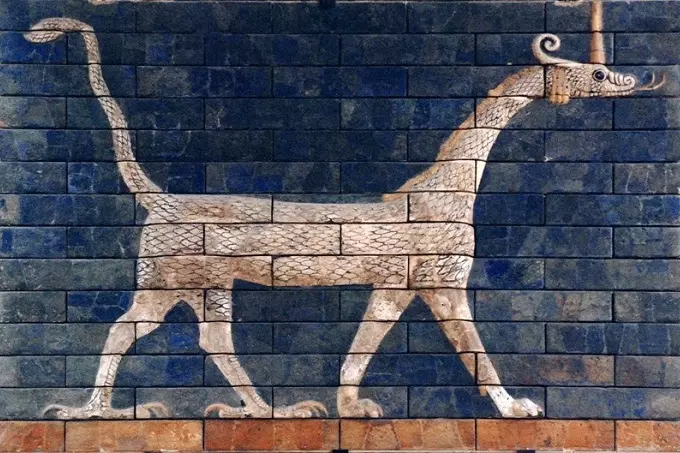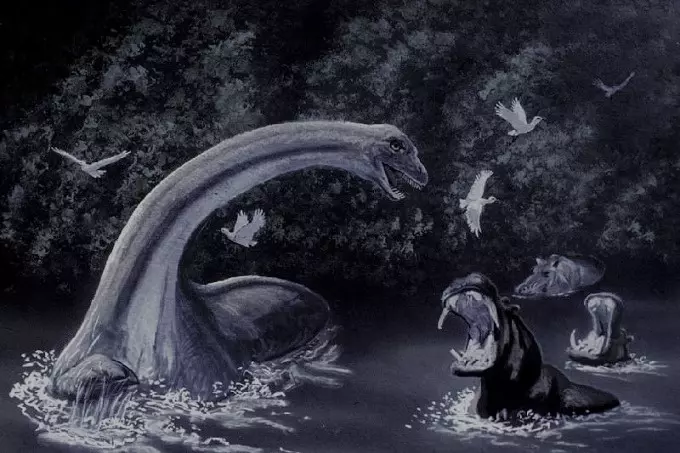Is Sirrush from the Ishtar Gate an African dinosaur?

In 1902, after extensive archaeological work, the gates of Queen Ishtar reappeared on the site of ancient Babylon (the ruins are located on the outskirts of the modern city of Al-Hilla, Iraq), hiding under the earth for many centuries. Partially destroyed, they nevertheless looked very impressive.
The Ishtar Gate is a huge semicircular arch, bounded on the sides by giant walls and opening onto a rather long procession path, along which walls also stretched to the right and left. All this is built of brick, covered with bright blue, yellow, white and black glaze.
To heighten the magnificence, the walls of the gates and the paths are covered with bas-reliefs of extraordinary beauty, depicting animals in natural poses. Rows of sedately marching lions adorn the walls of the walkway. The gate is covered from top to bottom with alternating rows of images of two other animals.
One of them is a powerful bull with a ferocious look, and the second… this is where the zoological puzzle begins. Usually, this second animal is called the Babylonian dragon, and it is the same animal that appears under the same name in the Bible. Its Babylonian name, Sirrush, is preserved in cuneiform inscriptions.
In total, there are about 575 images of animals on the gates. The construction is impressive, and it is not surprising that King Nebuchadnezzar, who rebuilt the Ishtar Gate, was very proud of them. When the work was completed, he composed the inscription, which was made in cuneiform and put on public display. The text does not ignore the images of animals.
“Fierce bulls (in the original, they are called “rimi”) and gloomy dragons are inscribed on the courtyard of the gate (meaning the walls), by which I gave the gate an extraordinary and luxurious splendor, and the human race can look at them in amazement.”
The human race and the truth, in amazement, looked at them for many centuries. Of course, in those days, no one cared about zoological certainty. The lions on the walls of the path were lions, the tours on the gates were tours, even though they were somewhat unusual; and the details with which the artisans of Nebuchadnezzar considered it necessary to decorate the monsters depicted by them did not interfere with anyone.
Sirrush bas-reliefs have a very clear contour and depict a narrow body covered with scales, a long and thin scaly tail and an equally long and thin scaly neck with a snake head. The mouth is closed, but a long forked tongue protrudes from it. Leathery ears are visible on the back of the head, decorated with a straight horn – a good weapon. It is possible that there are two horns, since only one horn is also visible on the image of the tur-rimi.
“It is very remarkable,” Koldewey writes, that, despite the scales, the animal has hair. Near the ears, three spiral strands fall from the head, and on the neck, where the crest of a lizard should be, a long row of curly curls stretches. But the most remarkable detail is the paws. The front paws are similar to the paws of an animal from the cat family (say, panthers), and the back paws are bird-like. They are very large, four-fingered, covered with strong scales. And despite the combination of such different details, the Sirrush looks alive, in any case, just like the rimi depicted next to it, if not more naturally.
Had anyone dug up the Ishtar Gate 100 years earlier, this combination of different legs could be considered sufficient proof that the magical snake is no more real than the winged bulls and human-headed birds of Assyrian and Babylonian mythology. But in a hundred years, Georges Cuvier managed to become the father of paleontology, Professor Marsh won the title of “father of dinosaurs” in America, and the views on biological science themselves have undergone tremendous changes.
Paleontologists have discovered dinosaur fossils with impossibly long necks and tails, huge torsos, and small or serpentine heads topped with horns (or possibly forked tongues, although these are unfortunately not preserved as fossils). There were even species that could not choose which was better – to walk straight or on all fours. They probably used one or the other method of transportation, depending on the circumstances.
Accordingly, Sirrush suddenly began to be perceived as something real and quite possible. Modern science can easily determine the type of lizard to which the Sirrush belonged, although it does not know the fossil remains of exactly the same variety, and the artist who depicted it probably made several minor errors.
But where did he come from? According to some scientists, from… Central Africa. The only place where he could live, remaining unnoticed, is Central Africa, the region of tropical rainforests and the Congo River basin. Therefore, all the rumors about some unknown large and terrible animal, nicknamed mokele-mbembe, which came from there, are very curious. They also reached the German big game hunter Hans Schomburgk many years before Koldewey wrote his first extensive work.
Schomburgk worked for Karl Hagenbeck, a wildlife dealer who supplied zoological gardens and ran a huge zoo at Stehlingen near Hamburg. In 1912, after returning from Africa, Schomburgk told Hagenbeck an amazing story. And he was glad when Hagenbeck did not ridicule him. Instead, he himself told Schomburgk that he had received similar information more than once from other sources.
These reports were retellings of a native rumor about a “dragon-elephant” hybrid believed to live in impenetrable swamps.
Arriving on the shores of Lake Bengweulu in Zambia, where the place seemed ideal for hippos, Schomburgk asked the natives why there was not a single hippopotamus in sight. The natives replied that there was a good reason for this.
They very seriously explained that a beast lives in the lake, which, inferior in size to hippos, nevertheless kills and eats them. He must be amphibious by habit: the beast comes ashore, but no one has ever seen its tracks.
“Unfortunately, I regarded this story as a fairy tale and did not conduct a further search. Later, I talked about this with Karl Hagenbeck, and now I am convinced that the beast belonged to some kind of lizard. I am of this opinion because Hagenbeck received reports from other sources that are in complete agreement with my observations, and with information received by me from the natives whom I interviewed. Gagenbeck sent a special expedition to Lake Bangweulu, but, alas, she did not even manage to find this lake.
The animal is said to be grey-brown in color, smooth-skinned, and similar in size to an elephant, or at least to a hippopotamus. It has a long and very flexible neck and only one tooth, but it is very long. Some people say it’s a horn. Some have mentioned a long, muscular tail like an alligator’s.
They say that canoes approaching the beast are doomed: the animal immediately attacks the boats and kills the crew but does not eat the bodies. This creature lives in caves washed out by the river on clay banks on steep bends. In search of food, they say, it crawls ashore even during the day and feeds only on vegetation. This feature does not allow him to explain everything with myths. I was shown his favorite plant. It is a kind of creeper with large white flowers, milky juice and apple-like fruits.

Scientists, having listened to these stories, laughed. What large unknown animals can we talk about when all of them have already been discovered! But too much similar evidence suggests that perhaps a large unknown animal is indeed hiding in the shallow reservoirs and rivers of Central Africa. It is most likely a reptile.
Naturally, the question arises: could a large reptile survive in Central Africa? The answer of zoologists is this: if somewhere she could survive, then only here, in Central Africa!
All over the world, all sorts of geological changes have taken place over the past 60 million years. Shallow seas flooded vast expanses of land, other areas dried up. Isthmuses appeared and disappeared again; tectonic forces piled mountains, and there was active volcanic activity. But Central Africa turned out to be geologically stable: the land mass there is exactly the same as 60 million years ago.
Finally, the continents north and south of the fiftieth parallels in both hemispheres went through a series of glaciations, but although they influenced the climate between the tropics of Cancer and Capricorn, this effect did not lead to dramatic consequences.
And Central Africa has not been subjected to geological cataclysms since the Cretaceous and has experienced only minor climatic changes. So if large reptiles have survived since then, you need to look for them in Central Africa.




